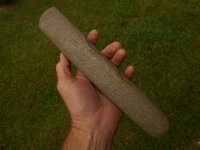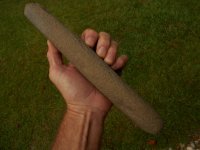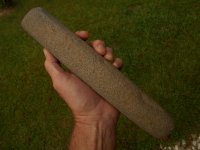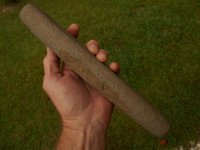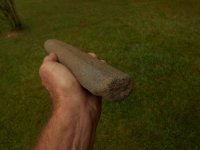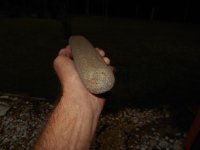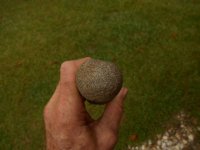Navigation
Install the app
How to install the app on iOS
Follow along with the video below to see how to install our site as a web app on your home screen.
Note: This feature may not be available in some browsers.
More options
You are using an out of date browser. It may not display this or other websites correctly.
You should upgrade or use an alternative browser.
You should upgrade or use an alternative browser.
Pestle From Lake Martin--S.W. Coosa County, Alabama
- Thread starter Tdog
- Start date
tnmudman
Hero Member
Thats really cool, I have seen similar pieces refered to as a roller pestle, or rolling pin. I would love to find one myself.
- Nov 3, 2018
- 3,139
- 6,756
- Detector(s) used
- O.G. XP DEUS
- Primary Interest:
- All Treasure Hunting
Its just a hand worn rock Terry!
Huzzah!
Sr. Member
What an awesome piece to have
welsbury
Bronze Member
I wonder if it was like a roller pestle and with that flat spot they could mash things,double duty? Sweet pestle
Tdog
Silver Member
- Thread starter
- #7
I wonder if it was like a roller pestle and with that flat spot they could mash things,double duty? Sweet pestle
Thanks for replying. It appears that the flat surface is wear from back-and-forth usage and the rounded end worn from rotating and mashing/pounding. The opposite end looks like wear from pounding. Not 100% sure though.
Last edited:
welsbury
Bronze Member
Waere you thinking there was a bowl to go with it?
MAMucker
Bronze Member
Great find!
Can you tell what it is made of?
Do you suppose stone pestles and grinding stones left a lot of stone grit in whatever was being mashed?
Can you tell what it is made of?
Do you suppose stone pestles and grinding stones left a lot of stone grit in whatever was being mashed?
Tdog
Silver Member
- Thread starter
- #11
Can you tell what it is made of?
Do you suppose stone pestles and grinding stones left a lot of stone grit in whatever was being mashed?
Thanks for your interest. I believe it is granite and yes I've always thought that there would be grit left in the food they were processing with these primitive tools.
quito
Silver Member
Great find!
Can you tell what it is made of?
Do you suppose stone pestles and grinding stones left a lot of stone grit in whatever was being mashed?
No doubt about it. Many Years ago while volunteering at a local dig with my son, we recovered a molar. It was worn perfectly flat. Just a few years ago they were moving dirt for a new development here in town. The scraper operator exposed to complete skeletons. Literally took the dirt right off them exposing them just about completely. A friend of mine talked to him soon after the incident and he said one of the first things he noticed were their teeth were worn pretty much flat.
joshuaream
Silver Member
Tdog, very cool find.
Not sure about your area, but there is a transition area where ancient groups started shifting away from flat-ish metate style stones to larger wooden mortars, bedrock mortars, or stone bowls/mortars. They usually processed corn while it was soft and then dried the mush into flour vs drying the corn and then making flour.
Not sure about your area, but there is a transition area where ancient groups started shifting away from flat-ish metate style stones to larger wooden mortars, bedrock mortars, or stone bowls/mortars. They usually processed corn while it was soft and then dried the mush into flour vs drying the corn and then making flour.
joshuaream
Silver Member
MAMucker
Bronze Member
Is there any consensus that these stone tools were sometimes used to smooth-out the insides of bowls as a finishing step before employing wooden pestles?
Last edited:
joshuaream
Silver Member
Is there any consensus that these stone tools were sometimes used to smooth-out the insides of bowls as a finishing step before employing wooden pestles?
People still use them in the Caribbean. Depending on the wood, big ones (maybe holding a 5 gallon bucket of stuff or more) are usually hollowed out with an adze, burned, and then worked smooth.
Some places still use stone pestles for really pulverizing stuff, and wood for smashing softer stuff. It depends on what they are making.
eyemustdigtreasure
Silver Member
- Mar 2, 2013
- 3,619
- 5,613
- Detector(s) used
- Fisher Gold Bug Pro
Tesoro Cibola
Nokta Pointer; Phillips SHS5200 phones
Nokta Macro SIMPLEX +
- Primary Interest:
- Metal Detecting
Great Find! 
Looks like it was used as a pestle and a mono,
which is not unusual.

Looks like it was used as a pestle and a mono,
which is not unusual.
IMAUDIGGER
Silver Member
- Mar 16, 2016
- 3,398
- 5,195
- Primary Interest:
- All Treasure Hunting
I have always read that Native Americans had very poor teeth due to eating food which had been processed with stone tools. Many lived to be very old, but their teeth were worn down flat.
Users who are viewing this thread
Total: 2 (members: 0, guests: 2)


